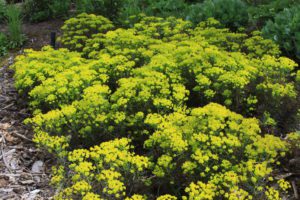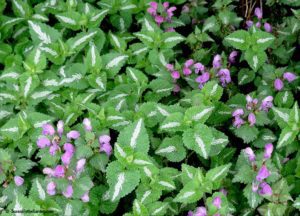May 15 column: Invasive Plants

Some readers might take issue with my column in today’s edition of The Spokesman-Review. Here’s a link to it: Some plants set on dominating the garden. You can also read my column lower in this post. The topic is invasive plants that have done their best to take over my garden. I tried to approach it from a fairly humorous point of view. That’s because we can’t let things like this get us down, right?
A few years back, I was taken to task for including Lady’s Mantle (Alchemilla mollis) on my list of troublesome plants. Yes, I agree it’s a lovely plant, especially when water has pooled on its leaves following a rainstorm. And its golden flowers add an ethereal look to the plants.
But! If you don’t deadhead before the flowers set seed, oh my! I can attest to the fact that I’ve got hundreds of plant starts in my garden. And even in my lawn (sigh) because I’m not always able to cut off the flower stalks in time.
In addition to Lady’s Mantle and the other three plants I discuss in my column, there are a few others that I’m occasionally battling with: Gooseneck Loosestrife, marjoram and two anemone cultivars (‘Snowdrop’ and ‘September Charm’). The problem is, I really like all of these plants… it’s just that I want them to behave themselves!
Anyway, I hope you’ll enjoy reading through today’s column. Here are photos of two other plants I mention in it, since there’s only room for a single photo in my column (I don’t have a photo of Rose Campion, sorry):
Euphorbia cyparissias (Cypress Spurge):

Lamium maculatum (Dead Nettle):

Invasive Plants garden column:
by Susan Mulvihill
Every gardener loves it when their plants grow vigorously. But what happens when some of them grow with a little too much enthusiasm?
I’d like to say I’ve never met a plant I didn’t like, but a few have worn out their welcome in my garden. It all started out innocently enough: I saw them in a nursery and they insisted I take them home. I’m certain once they were planted, they quickly plotted their strategy for taking over the flower beds.
Lamium maculatum is once such plant. Perhaps its common name, Dead Nettle, should have given me a clue it would be up to no good. I purchased a single ‘Pink Pewter’ to fill in underneath some rose bushes. It has attractive variegated leaves, is extremely hardy and tolerates dry soils.
At the time, I didn’t realize it’s a member of the mint family; that would’ve been my second clue. Anyone who’s ever grown mint is very familiar with its habit of taking over the planet. It has since taken over the entire bed and has appeared in other planters far, far away.
The second plant that’s on my hit list is Alchemilla mollis, or lady’s mantle. It has beautiful pale green leaves that are gorgeous after a rainstorm — or after the sprinklers run — because of the way the water droplets pool on them. In the summer, they have abundant golden blooms that brighten up the garden beds. But woe be unto any gardener who doesn’t deadhead those flowers before they set seed. I have so many of these plants throughout my garden, it’s impossible to keep up with them.
Lychnis coronaria is another plant that I have a love-hate relationship with. With a prim and proper common name of Rose Campion, you’d think it’d behave itself. I first spied this plant while on a garden tour. It has fuzzy, silvery-green foliage that grows 2 to 3 feet tall, but what really drew my attention were the eye-popping magenta flowers. I asked the homeowner what they were.
She immediately offered to give me some seedlings, then hesitated and said, “Um, they can be a bit exuberant in the garden.” That mild warning didn’t put me off, and soon I was heading home feeling a bit exuberant myself about having new plants.
Little did I realize what she meant. While they grew beautifully and bloomed prolifically, I soon spotted those silvery-green plants everywhere. Since they’re drought-tolerant and deer-resistant — two of my favorite attributes — I let them go for it. Once I realized I was going to have an entire garden consisting of Rose Campion, I started selectively removing those that were growing where I’d never intended.
Yet another troublesome plant is the groundcover, Euphorbia cyparissias, or Cypress spurge. Looking like tiny pine trees, I was immediately drawn to the glow-in-the-dark yellow bracts that make a bed pop with springtime color.
I planted three of them and they quickly went forth and multiplied — to the tune of hundreds of plants. If you’re looking for petite (9 inch) plants that are drought-tolerant and deer-resistant, and you want them to grow with great abandon, this plant is for you.
What have I learned from my experiences with these plants? First and foremost, read plant labels carefully for clues that they might be a tad more robust than I was hoping for. Listen to the experiences gardening friends have had with these plants. And keep a close eye on how the plants are growing before things get out of hand.
